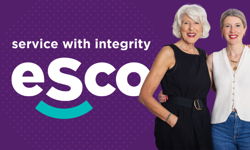Net promoter score, negative (and positive!) word of mouth index, CSAT et al are all ways of measuring customer satisfaction and these tools are now used widely across all industries, including media.
Being customer-centric and meeting customers’ expectations when it comes to service is now a necessity for every business. In an increasingly competitive world, dominated by social media and where customers have choices and make purchase decisions based on the experiences of other fellow customers, we can’t afford to give bad customer service. As Jeff Bezos said: “If you're competitor-focused, you have to wait until there is a competitor doing something. Being customer-focused allows you to be more pioneering.”
‘Delight’ is expensive
CEB conducted surveys of over 100k customers, across 12k different services both sides of the Atlantic, which show that customers’ loyalty increases as service improves (see graph). However, as you can see from the shape of the curve, the loyalty improvement rate diminishes when service is ‘over the top’. Your customers simply want what you have sold to them delivered in an efficient and convenient way – no need to give them anything extra. The same research warns that we should worry most about a negative word of mouth index or the sharing of negative experiences in service as these can not only damage loyalty but also brand reputation.
Motivated by these factors, I would suggest giving thought to the key questions outlined below when establishing your customer and marketing strategies:
* What effect does an increase of 1% in retention rates have on your bottom line?
* How much money can you save if your marginal (most expensive) acquisition activity is removed from your marketing plan, replaced by a combination of improved loyalty rates and increased cross-sales?
* How much extra revenue can you secure via your website, if you increase conversion rates by 1%?
* What is the average profit that you achieve from your top customers and prospects if they remain marketable? (ie. do not opt out)
* Are you attracting new prospects at the same rate as your existing customers and prospects are asking to be unsubscribed from marketing efforts? And are they of the same quality? (ie. if you replace a paying customer with a competition entrant, the health of your marketing database will deteriorate rapidly.)
Aviation lessons
Before expanding into the detail of this work, I want to draw a comparison with another industry:
I am a frequent traveller and have been for over a decade.
These days, I mainly travel within Europe and EasyJet is my most frequented airline (with Ryanair a close second) – yes, not so glamorous. I am amazed at how both of these companies have changed. For them, being cheap used to be cool. And customers had to accept, therefore, that service came second. But those days are over, with both airlines now focusing on improving the customer experience, which they have clearly realised drives repeat purchase, loyalty and therefore improved profits.
Technology has been a major factor in their ability to deliver a better customer experience, and nowadays, this is scalable. For my last EasyJet flight, I checked in with one click through my app; sent my boarding pass to my passbook on my phone; received push notifications at the airport to inform me of a slight delay to my flight (which wasn’t good for my wallet!); another that the gate had opened; and one more when the gate was about to close.
Even the mighty Michael O’Leary has now been talking about the importance of good customer service and has hired a CMO whose main focus is improving the customer experience. As he said: “I was wrong; the customer is always right. People used to come to us for the low prices and put up with the service. I don’t want them to have to put up with the service anymore.”
The good news for businesses is that customers are willing to pay extra for good service. Now that airlines serve half-decent (albeit overpriced) food, most passengers spend a small fortune on board. And believe me, I no longer feel as special holding my ‘Easyjet Plus’ card, which I’ve paid close to £200 for, because the number of passengers who are now producing one has increased significantly.
At Simply Business, the business insurance provider where I now work, after over seventeen years in the publishing industry, putting customers at the heart of everything we do has been a key strategy driving our rapid growth.
So for consumer publishing, an industry where driving efficiencies is essential, how can you learn from these organisations to deliver a better customer experience without reducing profit margins?
I have summarised below the top ten things I would advice doing:
1. Understand your customers better: ask them what they are interested in, and what they would like to get from you. I am sure you will get a good response and for those who don’t tell you, track what content they are looking at online, together with their purchase history, demographic information and marketing channel interaction, to formulate an engagement strategy.
2. Analysis, analysis and more analysis: conduct detailed recency, frequency, monetary value (RFM) segmentation which together with demographic information, will allow you to segment your customers and target each in a different way, maximising key metrics (open, click through and response rates).
3. Using all of the information above, you can start tailoring your content and using personalisation tools: show different versions of your website and all your communications, including email newsletters, to each of your customers.
4. Put yourself in the shoes of the customer – take out subscriptions to your brands as this will allow you to examine what the customers are experiencing – you will be surprised how things change when you consider yourself a customer. And speak to your customers. Last week, I spent a considerable amount of time listening to customer calls at the Simply Business offices in Northampton – not only did I get to know our customers better but I also thought of many opportunities to drive our business forward.
5. Conducting extensive analysis to ascertain the optimum number of messages to send to customers to drive maximum engagement is essential.
And armed with this information, you can plan a series of communications and feed into these all of the exciting offers and new products that you want to showcase to your customers. But be sure to analyse when you should stop. Looking at your customers in their segments, you can ascertain after how many messages opt-out rates increase logarithmically (or indeed disengagement kicks in and there are no openings of or click throughs to your messages) and therefore limits can be set at a database level but also within your CRM series.
6. Use technology to improve the customer experience without increasing your costs. You can now test sending the first issue of a magazine soon after order and even test sending an issue for delivery the day after – some publishers are moving into the Amazon era… I am sure you can too!
7. And if you can’t, think of other ways of bridging the gap – for example, can you send a discount voucher that the customer can redeem at their local newsagent so that they can get their first issue straight away.
8. You can also email your customers every time an issue is being mailed to tell them about all the key features they can look forward to reading – and, as I’m certain these emails will have high open rates, you may be able to successfully include renewal messaging in them.
9. You may also consider giving your customers access to a loyalty scheme – there are many plug and play suppliers out there, so testing how much improvement in renewals and conversions you can achieve through giving your customers access to special benefits should be available to everyone.
10. And think of any other engagement messages you can send: if you know your customers’ birthdays, send them a special e-card, tell them about the gifts and discounts they can get if they introduce their friends and families to your brands and run exciting competitions that they can participate in.
These are just some of the initiatives that can help you to drive loyalty rates. Driving loyalty and engagement is a long-term project, but you can start seeing improvements within the first few months.
My closing advice is: take a subscription to your own brand ASAP, ideally one that you like as a consumer, and start mapping out all of the communications you receive. And then, and only then, you may come to the conclusion that a customer-centric approach is not just worth exploring, but is a necessity. And if you feel rather overwhelmed with the task, start small, test, analyse, test some more and when you are ready, roll out. We are direct (or should I say performance) marketers after all!












